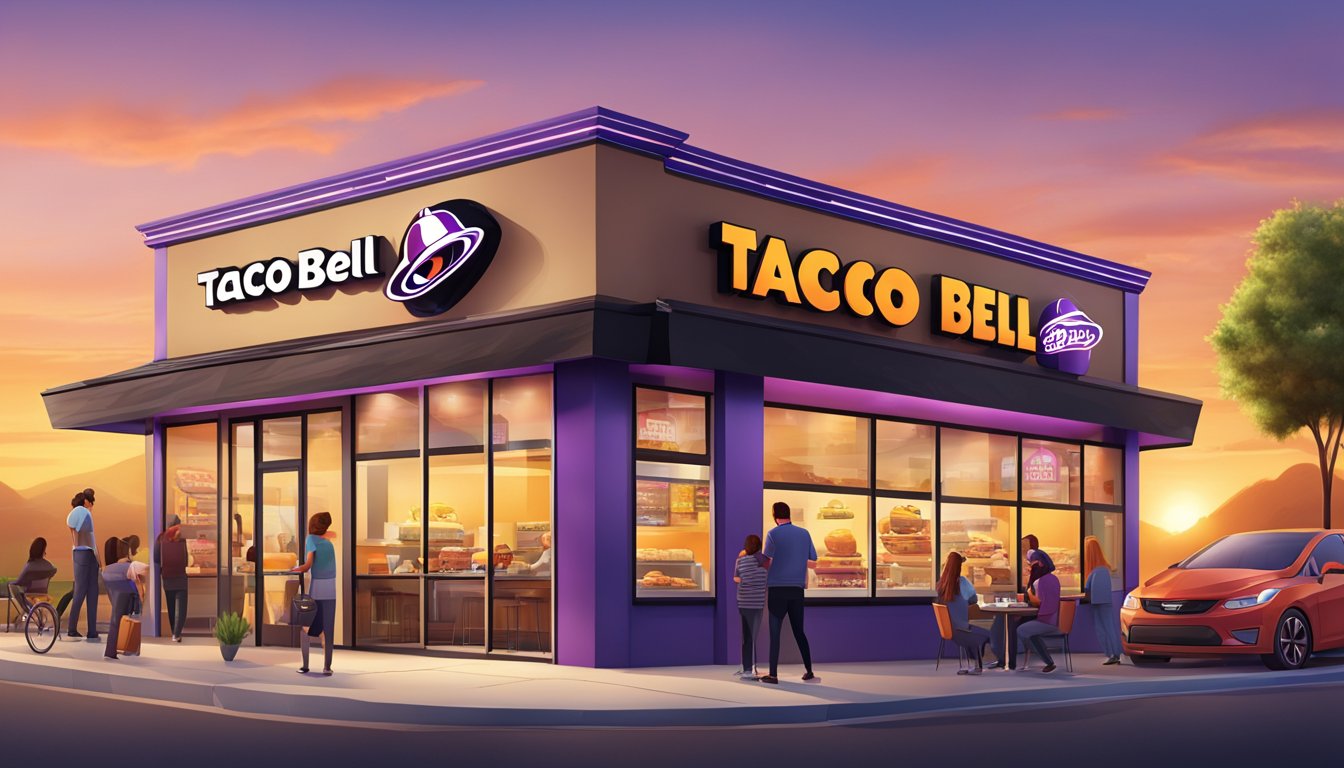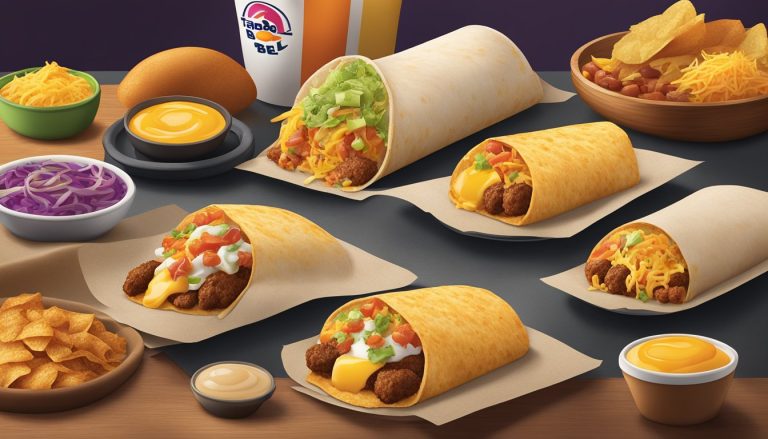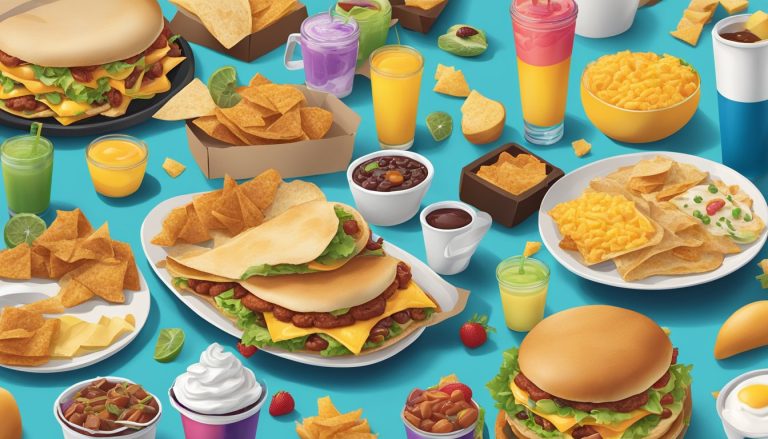Taco Bell made waves in the fast food industry when it launched its breakfast menu nationwide on March 27, 2014. This bold move marked a significant shift in the morning dining landscape, introducing innovative items like the Waffle Taco and Breakfast Crunchwrap that challenged traditional breakfast offerings.
The introduction of Taco Bell’s breakfast menu was supported by the brand’s largest marketing campaign to date. This strategic push aimed to capture a share of the lucrative morning market, long dominated by established players like McDonald’s. Taco Bell’s unique approach to breakfast set it apart, appealing to customers seeking a fresh twist on their morning meals.
Nearly five years after its launch, Taco Bell’s breakfast offerings continue to thrive. The success of this menu expansion demonstrates the brand’s ability to adapt and innovate in a competitive fast food landscape. By bringing its signature Mexican-inspired flavors to the breakfast table, Taco Bell has carved out a distinct niche in the morning rush.
The Rise of Taco Bell in the Fast Food Breakfast Arena
Taco Bell made a bold move into the fast food breakfast market in 2014, shaking up traditional offerings with its unique Mexican-inspired menu items. This strategic expansion aimed to capture a new customer base and increase sales during morning hours.
Historical Context of Fast Food Breakfast
Fast food breakfast emerged in the 1970s when McDonald’s introduced the Egg McMuffin. Over the decades, breakfast became a crucial revenue stream for many chains. By the early 2000s, breakfast accounted for a significant portion of fast food sales.
Market research showed growing demand for convenient, on-the-go morning meals. This trend led to increased competition among fast food giants. Companies invested heavily in developing new breakfast items and marketing campaigns to attract early risers.
Overview of Taco Bell’s Breakfast Launch
Taco Bell officially entered the breakfast arena on March 27, 2014. The company rolled out its morning menu nationwide, backed by its largest marketing campaign ever. This launch marked a significant shift for the brand, known primarily for lunch and late-night offerings.
The new menu featured innovative items like the Waffle Taco and Breakfast Crunchwrap. These products combined familiar breakfast ingredients with Taco Bell’s signature flavors and formats. The chain aimed to differentiate itself from competitors by offering a “Mexican-inspired” twist on traditional breakfast fare.
Taco Bell’s breakfast initiative targeted younger consumers seeking alternatives to conventional fast food morning options. The company’s strategy focused on affordability, portability, and unique flavor combinations to appeal to this demographic.
Analyzing Taco Bell’s Breakfast Menu

Taco Bell’s breakfast menu revolutionized fast food morning offerings with innovative items and unique flavor combinations. The chain introduced a bold lineup that set it apart from traditional breakfast fare.
Signature Breakfast Items and Innovations
The Waffle Taco stood out as Taco Bell’s flagship breakfast item when the menu launched in 2014. It featured a folded waffle filled with scrambled eggs, cheese, and a choice of bacon or sausage.
The Breakfast Crunchwrap became another popular option. This hexagonal wrap contained scrambled eggs, hash browns, cheese, and meat, all enclosed in a grilled tortilla.
Cinnabon Delights offered a sweet option – warm, bite-sized pastries filled with Cinnabon frosting. These treats quickly gained a following among customers seeking a dessert-like breakfast.
The Biscuit Taco later replaced the Waffle Taco, featuring a biscuit shell filled with eggs, cheese, and meat. This item demonstrated Taco Bell’s willingness to evolve its breakfast offerings based on customer feedback.
Comparison to Traditional Breakfast Offerings
Taco Bell’s breakfast menu diverged significantly from standard fast food morning fare. While competitors focused on pancakes, muffins, and traditional breakfast sandwiches, Taco Bell emphasized Mexican-inspired flavors and portable formats.
The chain’s breakfast burritos incorporated ingredients like jalapeño sauce and pico de gallo, offering spicier alternatives to typical breakfast flavors. This approach appealed to younger customers seeking bolder taste experiences.
Taco Bell’s breakfast items were designed for on-the-go consumption, with most options easily eaten with one hand. This convenience factor set them apart from sit-down breakfast meals offered by some competitors.
The menu also featured unique combinations like the AM Crunchwrap, which included a hash brown inside the wrap – a departure from traditional breakfast sandwich structures.
Impact on Breakfast Market and Consumer Choices
Taco Bell’s entry into the breakfast market disrupted traditional offerings and reshaped consumer preferences. The fast food chain’s unique approach expanded options for morning diners and challenged established competitors.
Shift in Breakfast Habits and Trends
Taco Bell’s breakfast menu introduced bold flavors and unconventional items to the morning meal landscape. The Waffle Taco and Breakfast Crunchwrap became instant hits, appealing to adventurous eaters seeking alternatives to standard fare.
This innovation sparked a trend of breakfast mashups across the industry. Competitors responded by diversifying their own menus, leading to increased variety in fast food breakfast options.
Convenience remained a key factor. Taco Bell’s drive-thru service and portable menu items catered to busy consumers, reinforcing the growing demand for quick, on-the-go morning meals.
Taco Bell’s Target Demographic and Market Share
Taco Bell strategically targeted younger consumers, particularly millennials, with its breakfast offerings. This demographic was more likely to embrace non-traditional breakfast choices and respond to the brand’s quirky marketing campaigns.
The chain’s breakfast launch helped it capture a significant portion of the fast-food breakfast market. Within its first year, Taco Bell reported that breakfast accounted for 6% of its overall sales.
Taco Bell’s success prompted a competitive response from established players like McDonald’s and Burger King. This intensified rivalry led to increased marketing spend and menu innovation across the breakfast segment.
The expanded breakfast options benefited consumers through greater choice and value propositions. Fast food chains began offering more comprehensive breakfast deals to attract budget-conscious morning diners.
Strategic Marketing and Competitive Landscape
Taco Bell’s entry into the breakfast market involved targeted marketing strategies and navigating a competitive landscape. The company leveraged innovative campaigns and unique product offerings to differentiate itself from established players in the quick-service restaurant (QSR) industry.
Taco Bell’s Marketing Strategies and Campaigns
Taco Bell’s breakfast launch relied heavily on social media engagement and viral marketing tactics. The company created buzz through teaser campaigns and influencer partnerships. A notable strategy involved sending 1,000 burner phones to influential individuals, delivering cryptic breakfast-related messages to generate anticipation.
Heather Mottershaw, Taco Bell’s senior director of innovation, played a key role in developing unique breakfast items. The menu featured unconventional offerings like the Waffle Taco and Breakfast Crunchwrap, appealing to younger demographics seeking novel flavors.
Digital platforms became central to Taco Bell’s marketing efforts. The brand utilized Twitter, Instagram, and TikTok to connect with its target audience of 18-34 year-olds. User-generated content and interactive challenges boosted engagement and brand awareness.
Competition and Differentiation in the QSR Industry
Taco Bell faced stiff competition in the breakfast segment from established players like McDonald’s and Dunkin’. These chains had long-standing breakfast traditions and loyal customer bases.
To stand out, Taco Bell emphasized its Mexican-inspired flavors and non-traditional menu items. This approach contrasted with the classic egg sandwiches and coffee offerings of competitors.
The brand positioned itself as a disruptor in the breakfast space. Its “Breakfast Defectors” campaign directly challenged McDonald’s dominance, encouraging consumers to break from routine and try something new.
Taco Bell’s late-night reputation helped attract younger customers to its breakfast menu. The brand leveraged its image as a destination for adventurous eaters to drive breakfast trial and adoption.
Operational Excellence Behind Taco Bell’s Breakfast Success

Taco Bell’s successful breakfast launch relied on meticulous planning and streamlined operations. The fast-food chain optimized its supply chain, developed unique menu items, and implemented efficient morning service logistics to capture the breakfast market.
Supply Chain and Menu Item Development
Taco Bell partnered with key suppliers to ensure a steady flow of fresh ingredients for its breakfast offerings. The chain focused on creating distinctive items like the Waffle Taco and A.M. Crunchwrap to differentiate itself from competitors. These products were designed for quick assembly, aligning with Taco Bell’s fast-service model.
Menu testing occurred in select locations to gauge customer response and refine recipes. The company invested in specialized equipment to prepare breakfast items efficiently. Taco Bell’s product development team worked closely with operations to ensure new menu items could be prepared quickly and consistently across all locations.
Logistics of Morning Meal Service
Taco Bell extended its operational hours to accommodate breakfast service, typically starting at 6 a.m. This required adjusting staff schedules and training employees on new procedures. The chain optimized its kitchen layout to handle both breakfast and regular menu items simultaneously.
Speed of service was prioritized, with a goal to serve customers within 60 seconds in the drive-thru. Taco Bell implemented a streamlined breakfast menu to maintain quick-service standards during morning rush hours. The company also invested in marketing to drive awareness and foot traffic during the new breakfast hours.
Inventory management systems were updated to track breakfast-specific ingredients and prevent waste. Taco Bell’s operational efficiency during breakfast service contributed significantly to its success in this new daypart.
Consumers’ Reception and Future of Taco Bell Breakfast
Taco Bell’s breakfast menu has seen significant success since its nationwide launch in 2014, reshaping consumer expectations for fast food morning offerings. The innovative menu items and aggressive marketing campaigns have driven strong sales and customer interest.
Customer Feedback and Sales Data
Taco Bell’s breakfast menu received positive reception from consumers seeking unique alternatives to traditional fast food breakfast options. The Waffle Taco and Breakfast Crunchwrap quickly became popular choices. Sales data showed promising results, with breakfast accounting for 6% of Taco Bell’s overall sales within the first year.
Customer reviews praised the bold flavors and creativity of menu items. Social media buzz helped drive awareness and trial. However, some consumers expressed concerns about nutritional content and portion sizes.
Projected Trends and Continued Innovation
Taco Bell continues to refine its breakfast offerings based on consumer feedback and market trends. The chain has introduced healthier options like the Power Menu Burrito to appeal to health-conscious customers. Vegetarian and plant-based breakfast items are also being explored to cater to changing dietary preferences.
Market analysts predict continued growth for Taco Bell’s breakfast segment. The company aims to increase its breakfast market share by expanding operating hours and introducing new limited-time offers to maintain consumer interest.
Digital ordering and delivery services are expected to play a larger role in Taco Bell’s breakfast strategy. The chain is investing in mobile app functionality and partnering with third-party delivery platforms to improve convenience for morning customers.
Taco Bell’s Breakfast Menu Nutritional Information

Taco Bell’s breakfast menu offers a range of options with varying nutritional profiles. The menu includes items featuring eggs, cheese, sausage, and bacon, with calorie counts and nutritional content tailored to different dietary needs.
Health Conscious Choices on the Breakfast Menu
Taco Bell provides some lighter options for health-conscious customers. The Potato Breakfast Taco contains 220 calories, making it one of the lower-calorie choices. For those watching their sodium intake, it’s important to note that many breakfast items contain significant amounts of sodium.
Egg-based items generally offer a good source of protein. Customers can customize their orders to reduce calories and fat by opting for items without cheese or meat. Taco Bell also offers orange juice as a beverage option, providing a source of vitamin C.
Comparison of Nutritional Values with Competitors
Taco Bell’s breakfast menu calorie counts are generally comparable to those of other fast food chains. The A.M. Crunchwrap options range from 630 to 670 calories, similar to breakfast sandwiches at other chains.
Taco Bell’s breakfast menu stands out for its unique items like the Waffle Taco, which offers a different nutritional profile compared to traditional breakfast sandwiches. The chain’s breakfast menu also includes coffee and Mountain Dew AM, a sugary soft drink option.
When comparing sodium content, Taco Bell’s breakfast items tend to be on par with competitors. However, exact nutritional comparisons can vary based on specific menu items and serving sizes across different chains.




